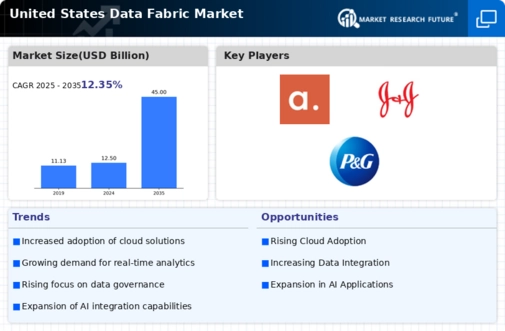Emergence of Edge Computing Solutions
The data fabric market is currently experiencing the emergence of edge computing solutions as a pivotal driver of innovation. As organizations seek to process data closer to its source, edge computing enables real-time analytics and reduces latency, which is particularly beneficial for applications in IoT and smart devices. This shift is expected to create new opportunities for data fabric technologies that can effectively manage and integrate edge data with centralized systems. Analysts project that the edge computing market could reach $43 billion by 2027, indicating a substantial growth trajectory. This trend underscores the necessity for data fabric solutions that can accommodate the unique challenges posed by edge computing, thereby enhancing the overall efficiency of data management strategies.
Integration of Multi-Cloud Environments
The data fabric market is witnessing a significant trend towards the integration of multi-cloud environments. As organizations increasingly adopt hybrid cloud strategies, the need for seamless data management across various cloud platforms becomes paramount. This integration allows businesses to optimize their cloud resources, enhance flexibility, and reduce costs associated with data storage and processing. Recent studies suggest that approximately 70% of enterprises are expected to implement multi-cloud strategies by 2026, which will likely drive the demand for data fabric solutions that facilitate interoperability and data consistency across diverse cloud environments. Consequently, this trend is poised to reshape the competitive landscape of the data fabric market.
Expansion of Data-Driven Decision Making
In the current landscape, the data fabric market is witnessing an expansion in data-driven decision-making processes across various sectors. Companies are increasingly leveraging data analytics to derive actionable insights, which in turn influences strategic planning and operational efficiency. A report indicates that organizations utilizing data-driven strategies are 6 times more likely to retain customers and 5 times more likely to make faster decisions. This shift towards data-centric approaches necessitates robust data fabric solutions that can unify disparate data sources, ensuring that stakeholders have access to comprehensive and accurate information. As businesses continue to prioritize data-driven methodologies, the demand for advanced data fabric technologies is expected to rise significantly.
Rising Demand for Real-Time Data Processing
The data fabric market is experiencing a notable surge in demand for real-time data processing capabilities. Organizations are increasingly recognizing the necessity of accessing and analyzing data instantaneously to make informed decisions. This trend is particularly pronounced in sectors such as finance and healthcare, where timely insights can significantly impact operational efficiency and customer satisfaction. According to recent estimates, the market for real-time data processing solutions is projected to grow at a CAGR of approximately 25% over the next five years. This growth is likely to drive investments in data fabric technologies that facilitate seamless integration and management of real-time data streams, thereby enhancing the overall agility of businesses in the data fabric market.
Growing Importance of Data Security and Privacy
The data fabric market is currently facing heightened scrutiny regarding data security and privacy. With increasing regulations such as the California Consumer Privacy Act (CCPA) and the General Data Protection Regulation (GDPR), organizations are compelled to adopt stringent measures to protect sensitive information. This regulatory landscape is driving investments in data fabric solutions that incorporate advanced security features, enabling businesses to safeguard their data assets while ensuring compliance. It is estimated that the market for data security solutions within the data fabric market could reach $20 billion by 2026, reflecting the critical need for organizations to prioritize data protection in their operational frameworks.

















Leave a Comment